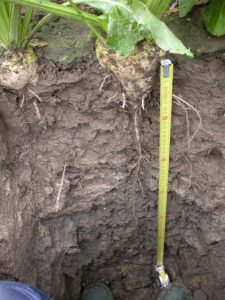Soil
Home > Soil > Considerations > Clay soils
Clay soils
Clay soils vary from region to region. The heaviness of the soil (the more lutum, the heavier the soil) and the lime content determine its properties.

Clay soils in the Flevopolders have a tillage layer that is still quite low in organic matter. As a result, the soil structure can degrade rapidly. They are then considered polder lowland soils. However, the soil structure in these young soils is better than in old marine clay soils. The structure improves when planted with crops such as cereals or grasses that leave behind a lot of organic matter. Green manures, solid manure and compost also improve structure. The timing of tillage is another important factor. Tillage in late autumn, often in wet conditions, largely determines the soil structure obtained. This has a powerful knock-on effect on the next growing season.
The older marine clay soils in the south-west and north of the Netherlands are highly productive when sufficiently fertilised. Yet even these soils have problems. Organic matter content is generally low, below three per cent, resulting in a poor soil structure. Underneath the tillage layer there is often a compacted layer about 20 cm thick, known as a plough sole. By their nature, clay soils are easy for roots to penetrate, but the use of excessively heavy machinery causes compaction. Growing grass and cereal crops keeps the subsoil open and early harvesting prevents compaction.
Calcareous clay soils
Calcareous clay soils occur in marine and river clays. They are generally heavy soils, known as bowl clay soils in the river clay region. The heaviness, combined with the lack of lime, makes them difficult to till. These soils are therefore especially suitable for grassland. A major concern on these soils is the need to exercise caution when considering driving on them in (excessively) wet conditions.
Sources:
Bokhorst, J. (2006). Bodem onder het landschap. Roodbont uitgeverij. Zutphen. ISBN 90-75280-94-7. 136 p.
Jongmans, A.G., M.W. van den Berg, M.P.W. Sonneveld, G. Peek en R. van den Berg van Saparoea (2012). De landschappen van Nederland; geologie, bodem, landgebruik. Wageningen Academic Publishers.
Koopmans, C.J., J. Bokhorst, C. ter Berg en N. van Eekeren (2012). Bodemsignalen. Praktijkgids voor een vruchtbare bodem. Roodbont Uitgeverij, Zutphen. 96 p.


